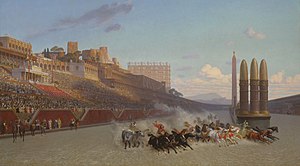 Global Information
Global InformationChariot racing information

Chariot racing (Greek: ἁρματοδρομία, harmatodromía; Latin: ludi circenses) was one of the most popular ancient Greek, Roman, and Byzantine sports. In Greece, chariot racing played an essential role in aristocratic funeral games from a very early time. With the institution of formal races and permanent racetracks, chariot racing was adopted by many Greek states and their religious festivals. Horses and chariots were very costly. Their ownership was a preserve of the wealthiest aristocrats, whose reputations and status benefitted from offering such extravagant, exciting displays. Their successes could be further broadcast and celebrated through commissioned odes and other poetry.
In standard Greek racing practise, each chariot held a single driver and was pulled by four horses, or sometimes two. Drivers and horses risked serious injury or death through collisions and crashes; this added to the excitement and interest for spectators. Most charioteers were slaves or contracted professionals. While records almost invariably credit victorious owners and their horses for winning, their drivers are often not mentioned at all. In the ancient Olympic Games, and other Panhellenic Games, chariot racing was one of the most important equestrian events, and could be watched by unmarried women. Married women were banned from watching any Olympic events but a Spartan noblewoman is known to have trained horse-teams for the Olympics and won two races, one of them as driver.
In ancient Rome, chariot racing was the most popular of many subsidised public entertainments, and was an essential component in several religious festivals. Roman chariot drivers had very low social status, but were paid a fee simply for taking part. Winners were celebrated and well paid for their victories, regardless of status, and the best could earn more than the wealthiest lawyers and senators. Racing team managers may have competed for the services of particularly skilled drivers and their horses. The drivers could race as individuals, or under team colours: Blue, Green, Red or White. Spectators generally chose to support a single team, and identify themselves with its fortunes. Private betting on the races raised large sums for the teams, drivers and wealthy backers. Generous imperial subsidies of "bread and circuses" kept the Roman masses fed, entertained and distracted. Organised violence between rival racing factions was not uncommon, but it was generally contained. Roman and later Byzantine emperors, mistrustful of private organisations as potentially subversive, took control of the teams, especially the Blues and Greens, and appointed officials to manage them.
Chariot racing faded in importance in the Western Roman Empire after the fall of Rome; the last known race there was staged in the Circus Maximus in 549, by the Ostrogothic king, Totila. In the Eastern Roman (Byzantine) Empire, the traditional Roman chariot-racing factions continued to play a prominent role in mass entertainment, religion and politics for several centuries. Supporters of the Blue teams vied with supporters of the Greens for control of foreign, domestic and religious policies, and Imperial subsidies for themselves. Their displays of civil discontent and disobedience culminated in an indiscriminate slaughter of Byzantine citizenry by the military in the Nika riots. Thereafter, rising costs and a failing economy saw the gradual decline of Byzantine chariot racing.